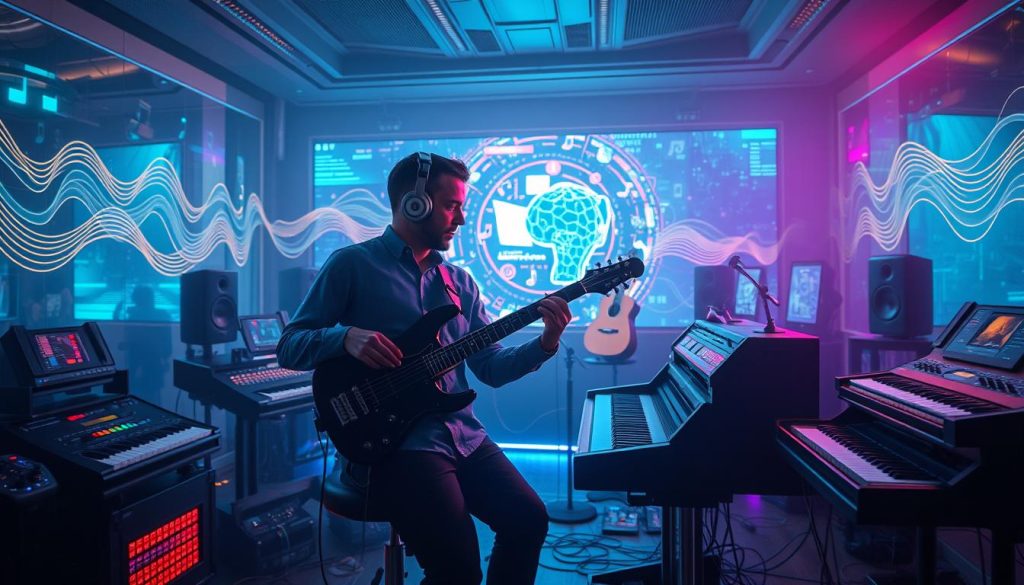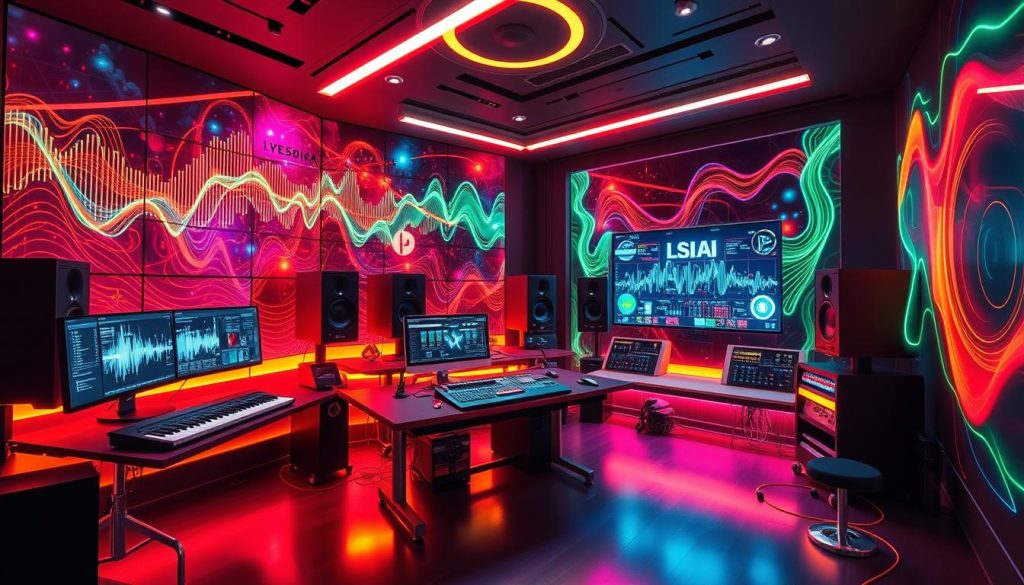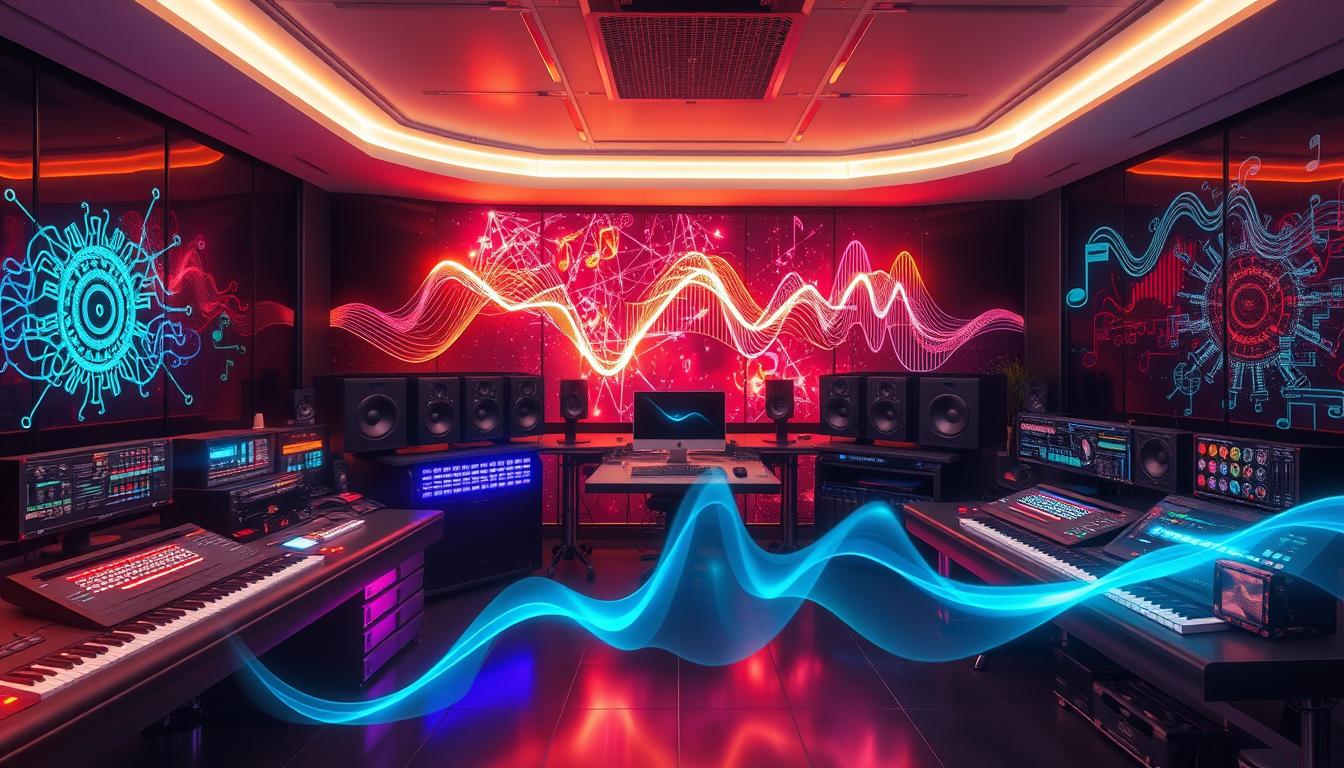I’m excited to see how artificial intelligence (AI) is changing music and audio. AI has brought new ways to create sounds. It’s making me look forward to what the future holds for our work.
AI can do things like automate boring tasks and come up with new musical ideas. But, the human touch in sound design is still key. It brings creativity, intuition, and feelings that AI can’t match. This makes me think about how AI and humans can work together.
Exploring AI in sound design is fascinating. It can make our work faster and better, and even make new music. But, it makes me think about what this means for my job and our creative world.
What is AI’s Role in Sound Design?
AI has changed the music and sound design world a lot. It can now do many audio tasks, like making new music and improving sound files.
Debates Around AI in Music
Using AI in music has opened new doors but also started debates. Some worry if AI music can feel as deep as human-made music. Others think AI might replace human composers and sound designers.
Current Capabilities of AI in Sound Design
Despite the debates, AI in sound design is really impressive. It can study music, find patterns, and make new tunes. It can also fix audio, remove noise, and create cool soundtracks for movies, games, and ads.
As AI gets better, its role in music and sound design will grow. Sound designers and composers will have to use AI to help their work. But they’ll still keep their own creative vision.
AI in sound design: The Advantages and Limitations
AI has changed sound design in big ways. It brings speed, efficiency, and new ways to make music. But, it also has limits we need to think about.
AI makes some tasks faster. It can do things like edit sounds, mix tracks, and master music. This lets audio experts spend more time on being creative. This means they can work faster and make more music.
AI also makes making music easier for beginners. It helps those new to the field make great music with less effort. This opens up more chances for different kinds of creators.
But, AI has its limits. It can’t match the creativity of human sound designers. Humans add a special touch that AI can’t copy. This touch comes from their feelings and unique way of seeing things.
AI also lacks the deep understanding of emotions and situations that humans have. This makes it hard for AI to make music that feels real and deep.
The debate between AI vs. human sound design shows both sides have good and bad points. AI is fast and easy to use, but it can’t replace the special touch of human sound design. Maybe the future is combining AI and humans to make amazing music together.
| Advantages of AI in Sound Design | Limitations of AI in Sound Design |
|---|---|
|
|
AI and Human Collaboration in Audio Projects

In the world of music, AI and humans are working together like never before. They’re changing how we make music. Artists are using AI to make their music even better. This shows how powerful AI and humans can be together in music.
Collaborations and Experiments
Stars like Brian Eno, Aphex Twin, and Hans Zimmer are leading this change. They’re making new kinds of music with AI. This has changed how we think about music and instruments.
These artists are showing us what’s possible when humans and AI work together. They’re making music that’s never been heard before. This inspires new musicians to try out AI in their work.
Their projects are making waves around the world. They’re showing us a future where AI and humans make music together often. This is exciting for music fans everywhere.
As AI becomes more common in music, we’re seeing new kinds of music. This mix of human skill and AI is opening up new ways to make music. It’s changing how we enjoy and think about music.
Exploring the Future of AI-Powered Sound Design

The digital audio world is changing fast. AI is making big steps in sound design. New tech in DAWs, sound software, and algorithms is opening new doors for sound designers. VR and AR are also changing how we make and use sound.
AI is going to change how sound designers work. It can do boring tasks automatically, make things faster, and help with creativity. This lets designers focus on the deep, emotional parts of their work. AI takes care of the easy stuff, making sound design better and more creative.
But AI won’t replace human sound designers. People bring a special touch to sound that AI can’t match. The future will be about working together. AI and humans will use their best skills to make amazing sounds.
Looking forward, AI and VR/AR will keep changing sound design. Designers who use these new tools will do great in the changing audio world.
| Feature | AI-Powered Sound Design | Traditional Sound Design |
|---|---|---|
| Workflow Efficiency | Automated tasks, streamlined processes | Manual, time-consuming processes |
| Creative Capabilities | Augments human creativity, generates novel ideas | Relies solely on human creativity |
| Adaptability to Emerging Technologies | Readily integrates with VR/AR, DAWs, and other tools | May require manual adaptation to new technologies |
| Personalization | Tailors sound design to individual preferences and needs | One-size-fits-all approach |
AI as a Creative Partner for Sound Designers
AI is changing the game in audio creation. Project Music GenAI Control is a big step forward. It’s made by Adobe Research’s talented team.
This tool uses AI to make music creation and editing easy and precise. Designers can make music from just a few words. This opens up new ways to be creative.
Elevating the Sound Design Process
Project Music GenAI Control is amazing because it combines AI editing with music making. Designers can start from scratch or tweak the music to fit their project. This makes their work easier and more artistic.
Using AI for music and editing, Project Music GenAI Control helps designers and technology work together. This lets designers focus on art and use AI for the hard parts. It makes their work better and more powerful.
AI tools like Project Music GenAI Control will change sound design. Designers who use this tech will see more creativity, easier work, and new limits in their work.
From Text to Speech: AI Voiceovers Transforming Audio Production
The audio production world is changing fast, thanks to AI voiceovers and text-to-speech tech. These tools are changing how we make and listen to audio. They bring new flexibility and efficiency.
The Rise of AI in Voiceovers
Machine learning and natural language processing have led to AI voiceovers that sound very human. Services like Elevenlabs have many voices and accents. Creators can make audio from text or change their voices into different styles.
These AI voices are very flexible and reliable. They’re great for videos, audiobooks, and corporate talks. They make sure the audio sounds the same everywhere.
| Feature | AI Voiceovers | Traditional Voice Recording |
|---|---|---|
| Customization | Highly customizable, with a wide range of voices and accents | Limited to the available voice actors and their specific characteristics |
| Consistency | Ensures a seamless and uniform audio experience | Can vary in tone, pacing, and quality depending on the voice actor |
| Efficiency | Allows for faster turnaround times and reduced production costs | Requires scheduling, recording sessions, and post-production editing |
AI voiceovers are getting better and being used in new ways. They’re being used for personalized audiobooks and voice interfaces. This shows how powerful this tech is.
AI voiceovers have raised questions about human voice actors. But, they also offer new chances for working together and being creative. As we move forward, we need to find a good balance. We should use AI tools and value human voice actors’ skills.
AI vs Human Voice Actors: Striking the Right Balance
The debate between AI and human voice actors is growing. AI is fast, efficient, and easy to use. But, it can’t match the emotional depth that human voice actors bring.
I think the future will mix AI and human talent. AI will help voice actors do more, opening up new creative ways. At the same time, human performers will add their special touch to AI’s strengths.
The aim is to find the perfect mix of AI and human voice actors. This mix will make audio experiences more engaging. I’m looking forward to seeing how these two work together in the future of sound design and audio production.

